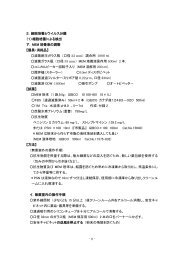Program and Abstracts(PDF)
Program and Abstracts(PDF)
Program and Abstracts(PDF)
Create successful ePaper yourself
Turn your PDF publications into a flip-book with our unique Google optimized e-Paper software.
1)Hamasaki, K., Tsuruoka, K. Teruya, K. Hashimoto, H. Hamada, K., Hotta, T., <strong>and</strong> K.<br />
Mushiake. 2009. Feeding habits of hatchery-reared larvae of greater amberjack Seriola dumerili.<br />
Aquaculture, Vol:288. Pp 216-225.<br />
Authors reared greater amberjack larvae to investigate their feeding habits during the early phase<br />
of seed production. Larvae were fed on three types of rotifers with different body sizes, <strong>and</strong> the<br />
survival, growth rate <strong>and</strong> gut contents of the larvae were examined. As the results of this research,<br />
authors suggest an appropriate feeding schedule for greater amberjack larvae during the early<br />
phase of seed production.<br />
2)Teruya, K., Hamasaki, K., Hashimoto, H., Katayama, T., Tsuruoka, K., Hayashi, T., <strong>and</strong> K.<br />
Mushiake. 2009. Ontogenetic changes of body density <strong>and</strong> vertical distribution in rearing tanks in<br />
greater amberjack Seriola dumerili larvae. NipponSuisanGakkaishi,Vol:75. Pp54-63.<br />
To obtain basic knowledge on sinking death syndrome which has been considered to be one of<br />
the causes of early mortality during the seedling production of greater amberjack, ontogenetic<br />
changes of larval body density were examined. A rearing experiment was conducted to<br />
investigate the effects of aeration rate (0.1-2.0L/min) on the vertical distribution, feeding,<br />
survival, growth <strong>and</strong> initial swim bladder inflation of larvae reared in 500-L tanks for 10 days<br />
post hatching. Greater amberjack larvae showed negative buoyancy. In tanks with aeration of 0.1-<br />
1.0L/min, larvae were distributed in the upper layer in the daytime <strong>and</strong> on the tank bottom in the<br />
nighttime after 3 days post hatching. Excessive aeration (2.0L/min) caused larvae to disperse in<br />
tanks. However, feeding amounts, <strong>and</strong> rates of survival, growth <strong>and</strong> initial swim bladder inflation<br />
of larvae were low in those tanks with rearing seawater of high turbulence. To prevent the larvae<br />
from sinking to the tank bottom, rearing techniques with less physical stress on larvae should be<br />
developed.<br />
3)Hirata, Y., Hamasaki, K., Imai, A., Teruya., K. Iwasaki., T. Hamada, K., <strong>and</strong> K. Mushiake.<br />
2009. Effects of different photoperiods <strong>and</strong> water temperatures on survival, growth, feeding <strong>and</strong><br />
initial swim bladder inflation of greater amberjack Seriola dumerili larvae.<br />
NipponSuisanGakkaishi,Vol:75. Pp995-1003.<br />
To determine the appropriate rearing conditions for early stage larvae of greater amberjack<br />
Seriola dumerili, we investigated the survival, growth, feeding <strong>and</strong> initial swim bladder inflation<br />
of larvae reared in two or three replicates in 500 L tanks under different photoperiods (0L: 24D,<br />
12L: 12D, 18L: 6D, 24L: 0D) <strong>and</strong> water temperatures (22, 24, 26, 28°C). In the 0L: 24D group,<br />
few larvae showed feeding incidence <strong>and</strong> growth, <strong>and</strong> total mortality occurred 8 days after<br />
hatching. Photoperiod (12-24 hours light condition) <strong>and</strong> temperature did not affect the larval<br />
feeding <strong>and</strong> swim bladder inflation, whereas larval survival <strong>and</strong> growth were improved in the<br />
18L: 6D group <strong>and</strong> larval survival was the best at 22°C.<br />
22



